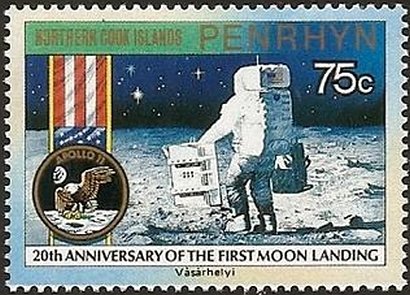Stamp: Astronaut mit seismometer (Penrhyn 1989)
Astronaut mit seismometer (Penrhyn 1989)
24 July (Penrhyn ) within release Moonlanding goes into circulation Stamp Astronaut mit seismometer face value 75 Cook Islands cent
| Stamp Astronaut mit seismometer in catalogues | |
|---|---|
| Michel: | Mi:CK-PE 501 |
Stamp is square format.
Also in the issue Moonlanding:
- Stamp - Neil Armstrong, Michael Collins, Edwin Aldrin face value 1.75;
- Stamp - Astronaut mit seismometer face value 55;
- Stamp - Astronaut mit seismometer face value 75;
- Stamp - Astronaut mit seismometer face value 95;
- Stamp - Neil Armstrong, Michael Collins, Edwin Aldrin face value 1.25;
Stamp Astronaut mit seismometer it reflects the thematic directions:
A landscape is the visible features of an area of land, its landforms and how they integrate with natural or man-made features. A landscape includes the physical elements of geophysically defined landforms such as (ice-capped) mountains, hills, water bodies such as rivers, lakes, ponds and the sea, living elements of land cover including indigenous vegetation, human elements including different forms of land use, buildings and structures, and transitory elements such as lighting and weather conditions. Combining both their physical origins and the cultural overlay of human presence, often created over millennia, landscapes reflect a living synthesis of people and place that is vital to local and national identity. The character of a landscape helps define the self-image of the people who inhabit it and a sense of place that differentiates one region from other regions. It is the dynamic backdrop to people’s lives. Landscape can be as varied as farmland, a landscape park, or wilderness. The earth has a vast range of landscapes, including the icy landscapes of polar regions, mountainous landscapes, vast arid desert landscapes, islands and coastal landscapes, densely forested or wooded landscapes including past boreal forests and tropical rainforests, and agricultural landscapes of temperate and tropical regions.
The Moon is Earth's only natural satellite. It orbits at an average distance of 384,400 km (238,900 mi), about 30 times the diameter of Earth. Tidal forces between Earth and the Moon have over time synchronized the Moon's orbital period (lunar month) with its rotation period (lunar day) at 29.5 Earth days, causing the same side of the Moon to always face Earth. The Moon's gravitational pull – and to a lesser extent, the Sun's – are the main drivers of Earth's tides.
A spacecraft is a vehicle that is designed to fly and operate in outer space. Spacecraft are used for a variety of purposes, including communications, Earth observation, meteorology, navigation, space colonization, planetary exploration, and transportation of humans and cargo. All spacecraft except single-stage-to-orbit vehicles cannot get into space on their own, and require a launch vehicle (carrier rocket).




